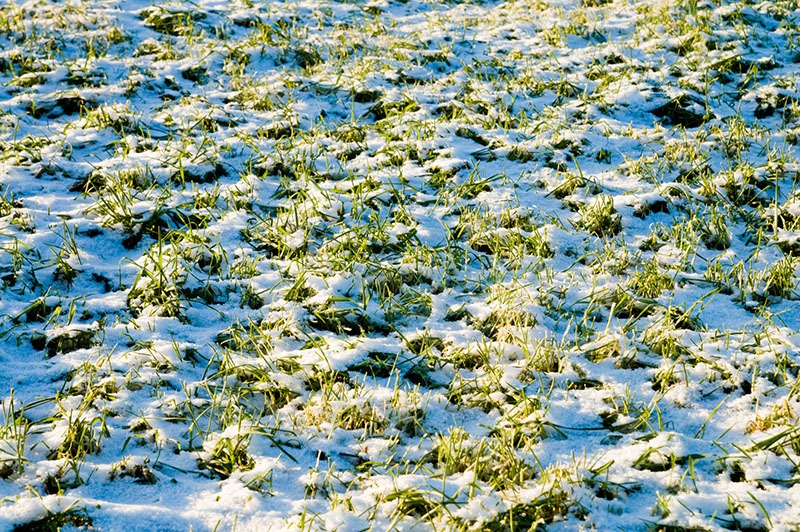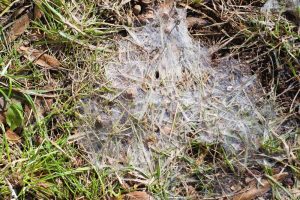
Winter is coming, and it will bring with it a slew of new challenges for your lawn. Cold temperatures, heavy rain, snowfall, and more all create the perfect conditions for turf diseases to flourish. Luckily there are ways to avoid common winter turf diseases to maintain your green space even in harsh weather. Read on to avoid common mistakes that can lead to winter turf diseases.
Winter Turf Diseases
As winter quickly approaches, it is important to take the necessary precautions in order to protect your turf from becoming diseased. There are many common mistakes that people make, which can lead to winter turf diseases.
There are several types of possible winter turf diseases. The most common diseases this time of year are winter brown spot, snow mold, and red thread. All of these diseases can cause extensive damage to your lawn if not treated early. Thus, it is important to be familiar with the symptoms and how to prevent them.
Winter turf diseases, like snow mold and gray leaf spot, can quickly take hold in cold weather conditions. To prevent them from occurring, it is important to understand the factors that lead to their growth. Common mistakes such as not properly aerating or mowing too short can make your lawn more prone to disease. Additionally, if you are using any chemical treatments, be sure to use them according to the manufacturer’s instructions.
Winter Brown Spot
This disease appears as small, circular patches of dead grass that range in color from light brown to dark brownish-purple. The disease is caused by winter weather. Specifically, prolonged periods of snow cover and temperatures below 50 degrees Fahrenheit trigger the spread of winter brown spot.
To treat winter brown spot, prune out dead patches of grass and remove the debris from your lawn. Water in a fungicide to help spread it through your winter brown spotted area, which will kill any spores left behind by winter brown spot.

Avoid snow mold and other winter turf diseases with proper lawncare.
Snow Mold
This type of turf disease appears as small black spots on grass blades or patches that resemble burnt patches in your lawn. Snow mold can be identified by its wintertime occurrence and gray-black sporulation on grass blades. This disease is a fungus that grows best in snow-covered areas. Especially when temperatures are below 50 degrees Fahrenheit for prolonged periods of time.
To treat snow mold, remove the snow cover as soon as possible and allow your lawn to dry out. Once it is dry, water in a fungicide to kill any spores present in your lawn.
Red Thread
This type of winter turf disease occurs in the late winter or early spring when conditions are moist, but not cold enough for snow mold or brown spot to grow. It is identified by light red or pinkish growths that resemble a thread along your lawn’s surface. This disease appears as red or pink threads that grow on grass blades. The disease thrives in wet environments with temperatures between 60 to 75 degrees Fahrenheit. It can cause extensive damage to your lawn.
To treat red thread, water in a fungicide and remove any dead patches of grass from your lawn. You should also aerate your soil to improve drainage and reduce moisture levels.
Preventing Winter Turf Diseases
There are several ways that you can prevent winter turf diseases on your property. Avoid these common winter turf disease mistakes with our tips:
Aerate
Aerate your lawn before winter begins so that nutrients can reach the roots and promote healthy growth.
Don’t Over-Fertilize
Take care not to over-fertilize your lawn. Too much fertilizer can cause the blades to grow too tall, creating an environment for winter brown spot to spread more quickly. Plus, too much fertilizer sitting on your lawn can attract pests, or choke out new grass shoots.
Apply Fungicides
In late autumn, take some time to apply a layer of fungicide before winter sets in. Homeowners can use lawn fungicides to control and prevent the fungus that leads to many lawn diseases.
All lawns are subject to diseases. However, poorly maintained and malnourished lawns are the most susceptible. Thus, the best way to avoid invasive fungus on your lawn is to prevent it in the first place. Fungicide application at this time is effective at preventing winter brown spot, snow mold, and red thread.
Keep It Mowed
A lot of disease prevention is simply preventing the conditions winter diseases need to flourish. These include prolonged periods of cold weather with moist soil in which spores can grow. Thus, you should keep your lawn mowed short throughout winter. Long grass will heat up during sunny days but quickly cool down when night comes around. This creates the perfect winter environment for disease to take hold, so keep your turf short and cool.
Clear Debris
Regularly rake away fallen leaves and debris from your lawn so that mold doesn’t have an opportunity to grow.
Takeaways to Prevent Winter Turf Diseases
Winter is the perfect time to enjoy many outdoor activities. Nd to take a short break from yard maintenance! But it’s also a time when turf diseases can become an issue. Thus, with a little effort, you can avoid the common mistakes that lead to turf disease.
Avoid these common winter turf disease mistakes with our tips: don’t over-fertilize, apply fungicides in late fall, and keep turf mowed short. These steps will do the trick to prevent the conditions winter diseases need to flourish. And with this prevention knowledge, you will maintain healthy green space all year long!
Start Fresh with a New Lawn
If you find that winter turf diseases have taken hold, it may be time to start fresh with a new lawn for the coming spring season. Ready to install new, lush, high-quality sod this winter or spring? Just reach out to the experts at The Turfgrass Group to learn more today!
